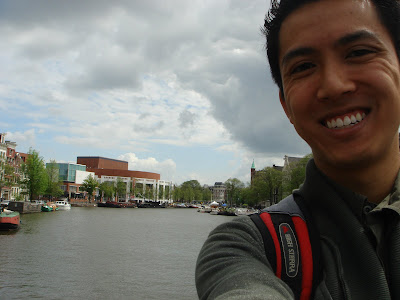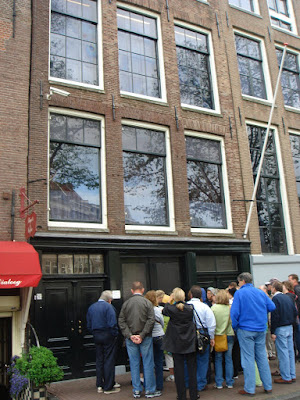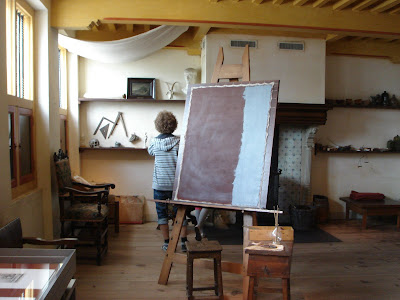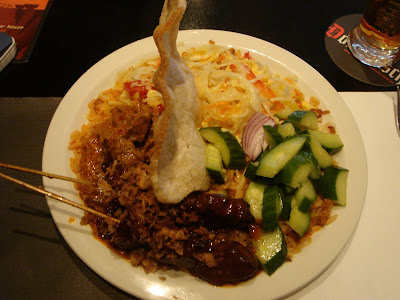This past Thursday, I decided to make a trip to Amsterdam. Earlier during the week, I was debating between going to Paris or Amsterdam. Each passing day I was monitoring the weather forecast for each city, seeing which one would be better. On Thursday night, I decided I was going to go to Amsterdam. I went to a BBQ that night with some of the other interns, so I didn't get back to my studio until 11:30 pm.
Planning on spending the entire weekend in Amsterdam, I forgot that I needed to book a hostel. I scoured the internet for hostels in Amsterdam and I come to realize that either they're all booked or they are 3+ miles away from the city center. Also, one thing I didn't realize is that most hostels require at least 2 nights stay on the weekends. However, I couldn't even find a hostel that had a bed available on Friday and Saturday. Instead of spending the weekend in Amsterdam, I decided that I would try to make it a day trip. If I wanted to go back, it's easy enough just to hop on a train.
I forgot to mention how I'm managing my use of the trains. Before I left for Europe, I bought a train pass called a Eurail Global Pass from this
website. With this train pass, you can travel on each eligible country's national rail line without any extra charge. There are 22 countries where this pass is valid and the only trains the pass does not cover are high speed trains. With regard to the cities I currently plan on visiting, I should only need to pay an extra charge to go to Paris and London. These extra charges are actually discounted as well, since I have this type of rail pass. When I say I'm hopping on the train, I'm doing just that. This rail pass allows me to evade the ticket lines to purchase individual tickets. I just arrive at the train station, park my bike in the parking garage, wait for my train, and then hop on.
The train ride to Amsterdam took 3.5 hours and included 1 change over. I traveled from Leuven to Brussels and then from Brussels to Amsterdam. To get the most out of my day, I boarded the 5:30 am train to Brussels and arrived in Amsterdam around 9:00 am.

Once I arrived in Amsterdam, I bought a city map. There was absolutely no way I could have navigated the city without one. It was incredibly helpful, however, my navigation skills could use some improvement . Immediately after I stepped outside the train station, the first thing I noticed were the canals that spanned the entire city. These canals cover over 100 kilometers and include over 1,500 bridges.


I planned that the first stop of my day would be the Anne Frank house. On the way, I stumbled across some coffee shops offering cannabis. Although visually they were easy to identify, the unique stench emanating from the store was much more noticeable.
Side note: Although cannabis is legal here, it doesn't mean that everyone uses it. Before coming to Amsterdam, I had the impression that a large majority of people in the city were users and that these coffee shops would be teeming with people. From walking around the city all day, I noticed that these shops were relatively empty and that more people smoke cigarettes than cannabis. I feel like a lot of mainstream movies give a false interpretation of Amsterdam.
Anyway, I eventually made my way to the the Anne Frank house.

When I got there, it was about 9:30 in the morning. After waiting in line for a little more than half an hour, I finally was inside.

This is the outside of the Anne Frank house. Taking photographs is prohibited inside, so unfortunately I can't provide pictures. Once you're inside, you can walk through the moving bookcase and peruse throughout the entire house. The hideout actually consisted of two floors, each with several small rooms. On display, they had Anne Frank's original diary flipped open to a page where you could see her handwriting and the edits she made throughout it. Throughout the house, there are news clippings and pictures posted onto the walls, which are still intact from when the house was raided in 1944.
After the Anne Frank house, I made my way to Rembrandts' house. His artwork wasn't actually on display. This month, there is a traveling exhibit of his friend, Jan Lievens.


This spot is where Rembrandt worked on his paintings. I was a little disappointed that I didn't get to see Rembrandt's works, but oh well, there was nothing that I could do about it.
After Rembrandt, I found my way to the Van Gogh museum.

Once again, photography was strictly prohibited. Van Gogh's works were organized chronologically such that you could see the evolution of Van Gogh's style. Some of the pieces on display included Wheat Fields, Wheat Fields with Crows, The Harvest, and Skull smoking a Cigarette. Pictures of Van Gogh's work in books pale in comparison to the originals. Most of Van Gogh's work is oil on canvas and what you don't see in books is the intricate texture that each brush stroke provides.
Walking around Amsterdam still, I found a Chinatown!

Continuing on with my travels, I found myself in the Red Light District.

In the Netherlands, in addition to cannabis, prostitution is legal. The windows on the left are where the women watch the world go by and try to grab customers. The scene is suppose to be completely different during the night hours, however, since I wasn't able to find a hostel, I can't attest to that.
After walking around all day, I decided to find somewhere to eat for dinner. I went through my travel book and found a place called Kantjil & de Tijger (Antelope and the Tiger). It was a modern Indonesian restaurant just outside the city center.

Tonight, I tried the nasi goreng Kantjil, accompanied with a dutch beer called Hertog Jan. The food consisted of fried rice, topped with pork kabobs, spicy stewed beef, pickled cucumbers, and vegetables. The food was delicious and pretty cheap too! The total bill was almost 14 euros.
After dinner, I had to make my way towards the train station to head home. My first train was from Amsterdam to Brussels. The train schedule was altered at the last minute, some stops being removed and others added. I ended up arriving in Brussels 20 minutes later than I was suppose to and in the process I missed my train at 10:56 pm to Leuven. The next (and last) train heading to Leuven would leave at 12:10 am, so I ended up having to wait in Brussels until then.